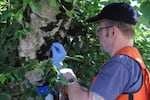
Geoffrey Donovan of the U.S. Forest Service collects a moss sample.
Sarah Jovan/US Forest Service
Forest Service lichenologist Sarah Jovan hardly has to walk half a block from her office in downtown Portland to find the type of shaggy, green moss she used to discover the city's hidden hot spots of toxic air pollution.
"I mean, it's just everywhere," she said. "You can see it on all these trees here, across the street. For a sample you'd need probably a couple handfuls."
Because moss gets all of its nutrients from the atmosphere, it's a natural air pollution monitor. But no one here was using it that way – until Jovan tested it out with Forest Service economist Geoff Donovan.
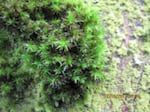
Researchers used orthotrichum moss, visible in trees all over Portland, to test for air pollutants in 346 different locations.
Sarah Jovan/US Forest Service
“Until we got into this I kind of assumed we knew what was in our air," Donovan said. "But we actually know very little.”
Their groundbreaking study uncovered levels of cadmium and arsenic pollution high enough to cause cancer. The results have state officials rewriting air pollution rules while residents run to their doctors for blood and urine tests. Experts are now saying given how little we know about what's in the air we're breathing and the cost of air monitoring, perhaps we should be consulting moss more often.
"The broader impact of this is just fantastic," Jovan said. "People are talking. Laws are going to change. It's like moss is finally getting its day in the sun."
She paused and added with a laugh: "Though, it probably wouldn't like that because it would dry out."
Solving an air pollution mystery
Donovan and Jovan didn't set out to expose toxic hot spots. Forest Service researchers have been using lichen to test air quality in forests for decades, and they wanted to try it in the city.
"What we wanted to do was see if trees could reduce our exposure to this class of air pollutants," he said. "And we did the study and we found trees can, in fact, protect us from some of these classes of carcinogens."

The moss in trees across the city of Portland can be used to test for air pollution.
Cassandra Profita, OPB / EarthFix
But that’s not all they found. In fact, what they found in the city’s tree moss wound up solving a mystery state regulators had been puzzling over for years. The city only has one permanent toxic air pollution monitor, and it was detecting more cadmium and arsenic it than should have been based on pollution permits. But it couldn't tell people where the extra heavy metals were coming from. Then, the data from hundreds of moss samples came in.
“We’re looking at these things thinking, ‘Wow. We didn’t see this one coming,’ he said. "I mean, most people don’t think of stained glass manufacturers as evil polluters. You don’t think of that at all. It was surprising, certainly.”
The moss revealed large cadmium hot spots near two artistic glass factories. The most concerning were the cadmium and arsenic levels near the Bullseye Glass plant. The company uses the metals to make colored art glass but isn’t required to test its emissions or use pollution controls. So, regulators didn't know how much heavy metal pollution the plant was emitting until the nearby moss samples raised a red flag.
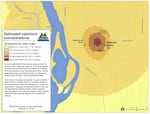
A map of the cadmium hot spot near Bullseye Glass in Southeast Portland.
Oregon Department of Environmental Quality
"Bullseye has been there in the same location since 1974, and they hadn't been detected," Donovan said. "We were able to say put an air monitor there. When the results came back, that was a tough day. You want your hypothesis to be right, but I wish we were wrong."
'It's been horrible.'
Based on the moss tests, officials put an air monitor near Bullseye Glass. The levels of cadmium and arsenic they found were unprecedented – high enough to cause cancer.
Sarah Livingstone lives five blocks from Bullseye. Weeks before officials announced the hazardous hot spots, she had rushed to the ER unable to breathe. She was diagnosed with pneumonia and a buildup of fluid around the lungs. After the news of the hot spot broke, she had her young daughter tested for metals and worried what what had caused her illness. When her lung problems hadn't cleared up, her doctor suggested testing for cancer.
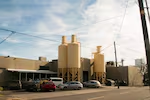
Bullseye Glass in Southeast Portland is one of two glass companies that has voluntarily stopped using cadmium in and arsenic in its manufacturing of colored glasses.
Bryan M. Vance / OPB
"It’s been horrible," she said. "Having a 16-month-old baby, and being told you could possibly have lung cancer, and knowing it could possibly be from a glass manufacturing glass five blocks from our house that was spewing, you know, toxic, carcinogenic heavy metals since 1974."
Related: Seattle Law Firm Files Class Action Lawsuit Over Portland Air Pollution
Livingstone says she feels betrayed by regulators who admit they didn't know what was in the air in her neighborhood.
"If the Forest Service hadn't presented them with the moss study would we even know about it now? No," she said.
'Looking under every moss carpet'
The whole ordeal has left many wondering what other toxic air pollution regulators are missing. Why aren’t we taking more moss samples?
At a news conference, U.S. Senator Jeff Merkley praised the Forest Service researchers – in large part for their thriftiness. It costs $150,000 a year to run an air pollution monitor that can only test the air in one place. The Forest Service spent $20,000 on moss sampling that tested for pollutants in more than 300 locations across the city.
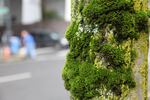
Measuring the contaminants stored in tree moss can help flag pollution hot spots.
Cassandra Profita, OPB / EarthFix
“I’m sure the use of moss is going to be expanded in all kinds of ways as a result of this excellent work,” Merkley said. “The science is fascinating because it’s so expensive to monitor air through normal air monitors, and you can only have a few of them. But you can take hundreds of moss samples, so that’s really valuable.”
Jovan said she's been contacted by dozens of citizens and neighborhood groups asking for advice on how to do their own moss testing.
"We’re getting a lot of requests from citizens who want to understand," she said. "They say, ‘I live in an arsenic hot spot. What does this mean? Can we test our moss?'"
Read: 7 Things You Need To Know About Portland's Toxic Air Situation
Vivek Shandas, an urban planning professor at Portland State University, said a lack of air testing means regulators don’t know if people are being exposed to harmful pollution at a neighborhood level – in any city, not just Portland.
"They're really showing us things we haven't been able to detect before," Shandas said. "The air under your nose is what you breathe, but we only know at a very general level across the metro region what the air quality is like."
He's hoping more moss testing could change that, and that his university might one day be able to help people test their own moss.
"It's inexpensive. It's relatively easy to get," he said. "Why aren't we turning over ever stone and looking under every moss carpet?"
'These are the type of dreams we have'
To test moss samples for air pollutants, scientists dry out and grind up the moss, liquefy it and run it through a machine that measures contaminants.
The results don't translate directly into air quality measurements, but they do reveal hot spots where pollution levels are higher, said Michael Amacher, the Forest Service chemist who processed all the moss samples for the Portland study. He said the lab work can easily be done elsewhere and help make up for a lack of air pollution monitors.
"There could be a point source of emissions that might leave a plume that only goes 2 or 3 miles," he said. "Unless an air quality monitor is within that plume, it's not going to catch it, but if there happen to be mosses on trees or lichens on tree bark or even on rocks those can be collected, and they will indicate what was in the air at the time."
Linda Geiser, national program leader for the U.S. Forest Service Air Resource Management Program, has spent decades using lichen to monitor air quality in forests and wilderness areas around the Pacific Northwest. But Portland's moss study seems to be having a bigger impact.
"I think this study has really hit closer to home because it's much more directly about human health as opposed to impacts of air pollution on the environment, which has really been the focus of our work to date," she said. "It's been pretty inspiring to see people catch on to how elegant this simple system can be."
Using moss to test air quality is common practice in Europe, she said, and the Portland study can be replicated in a whole lot of cities, though not all – some places are too hot and dry or too polluted for mosses and lichens to grow.
We're not quite at the point where we can just test moss instead of putting up air monitors. Jovan and Donovan with the Forest Service say they still need to do more research – pairing moss tests with air monitoring results – to convert moss test results directly into air quality measurements. But they say, that's the dream.
"If we were able to calibrate and actually say the moss tells us something that is directly applicable to an air quality standard, yeah, that is a really huge thing," Donovan said. "I don't think normal people have these dreams, but these are the type of dreams we have."
Meanwhile, they're heading to Cincinnati, where doctors are finding children with elevated mercury and cadmium in their blood. They don't know where the metals are coming from. But the city's moss could offer some clues.
